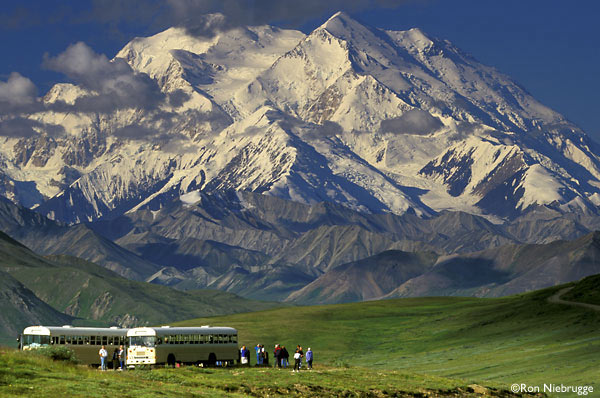McKinley, Mount
MOUNT MCKINLEY is the highest peak in North America with a summit at 20,329 ft (6,196 m). Located in the 600-mi- (965-km-) long Alaskan Mountain Range, it is approximately 150 mi (246 km) south of Fairbanks, ALASKA. Mount McKinley is home to more than 650 species of flowering plants, as well as mosses, lichens, fungi, and algae. The growing season is short, and only plants that have adapted to the region's cold winters can survive.
Mount McKinley is located near the center of the 6-million-acre Denali National Park and Wildlife Preserve. The terrain was carved by glacial activity approximately 10,000 to 14,000 years ago. Mount McKinley, or Denali, consists of two peaks that are permanently covered in snow. It is located by a major fault system, known as the Denali Fault, which makes it subject to continual tectonic uplift. A major earthquake in 1912 caused a significant segment of the south face of the mountain to shear off. Many smaller earthquakes occur each year, although they are generally unnoticed. Denali is surrounded by the rugged peaks of other members of the Alaska Range as well as open tundra, glacial rivers, and flood plains. The region is home to a diverse range of wildlife, including 167 species of birds, 10 species of fish, 39 species of mammals, and 1 species of amphibian.

Denali's climate is subarctic. Summers are short, dry, and generally cool. Cloud cover obscures the mountain's peaks much of the time. Winters usually bring heavy snows and extreme cold. The road system through the park is closed in the winter months. The rangers who are responsible for overseeing the protection and maintenance of the park often use dog sleds, going out on patrols of two or more weeks.
Mount McKinley was originally named Denali (“great white one,” or “high one”) by the Athapaskan natives, who lived and hunted around the mountain. McKinley was renamed in 1896 by William Dickey. Dickey, a Princeton University graduate who was performing a survey of the mountain following a prospecting trip, renamed it after presidential candidate William McKinley. Although Dickey claimed discovery of McKinley, the first sighting by a nonnative was actually nearly 150 years earlier by Vitus Bering in 1741.
Denali, as it is now called by the Alaskans, has a rich history of exploration. Unpredictable weather and rugged terrain, including swamp and crevasse-laden glaciers, that surround the mountain make climbing it a challenging and dangerous venture.
The first attempt to scale the mountain, which proved unsuccessful, was made around 1900 by Judge James Wickersham. Frederick Cook claimed to have reached its summit in 1907, but his claims were proven untrue three years later. The first successful scaling of the North Peak was accomplished by the so-called Sourdough Expedition Party in 1909. The South Peak was conquered by the Hudson Stock expedition four years later, in 1913.
The introduction of air travel drastically improved access to the region for exploration and surveying. Most of the region's bush pilots, including the legendary pilot-explorer Don Sheldon, fly out of the small town of Talkeetna, which is approximately 121 km (75 mi) south of Denali.
In 1936 and 1937, noted explorer-photographer Brad Washburn embarked on the first of many expeditions to climb and photograph Denali and the surrounding region. Washburn, whose expeditions were later joined by his wife, Barbara, provided an unparalleled glimpse of the mountains for those outside of the exploration community. Hundreds of books on Denali and the region have been produced that utilize Washburn's photographs.
Because of the extremity of McKinley's terrain, the mountain and its surrounding regions were a popular site for the development of search-and-rescue procedures by the U.S. Army's Tenth Mountaineering Core in the middle of the 20th century. Search-and-rescue remains an important part of life in the area. In 1980, under pressure from Alaskans, the UNITED STATES passed a bill to rename the mountain and its surrounding lands the Denali National Park and Preserve. The park is currently administered as a wildlife preserve by the U.S. National Park Service, which is a part of the U.S. Department of the Interior. In the mid-2000s, there have been pressures from the American political right to commence drilling for oil within the boundaries of the preserve.